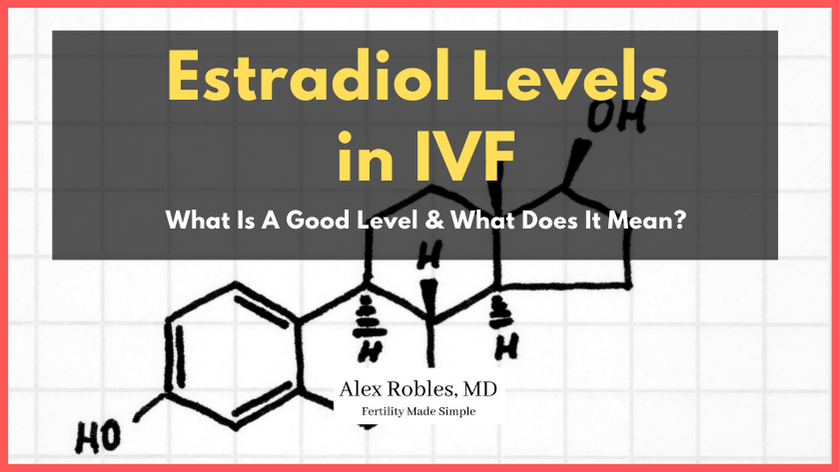Estradiol levels are essential for monitoring the progress of your in vitro fertilization cycle.
In this article, you’ll learn
- What the normal range for estradiol levels are in an IVF cycle
- What to expect the level to be on any given day
- What estrogen levels are considered high
Let’s get started.

What is a good estradiol level for IVF?
The actual value of your estradiol (E2) during IVF isn’t as important as the overall trend and the number of ovarian follicles you have growing.
The more follicles you have growing, the higher your estradiol level will be.
We like to see approximately 200-300 pg/mL of estradiol per mature follicle by the day of the trigger shot.
For example, an E2 level of 1000 might yield 3-5 mature oocytes at the egg retrieval (as not all follicles yield eggs).
*Note: Estrogen and estradiol are often used interchangeably.
What is the normal range for estradiol levels for fertility?
In general, your estradiol should increase regularly until it reaches its peak value, which is usually between 1,000 to 4,000 pg/mL in most patients.
At the start of your IVF cycle (on cycle day 3 or so), serum E2 levels should be below 80 pg/mL. By the end of your stimulation (the day of hcg administration), your estradiol can range from 200 pg/mL (if you only have one follicle growing), to over 5,000 pg/mL (if you have 20+ follicles growing.)
With that said, estradiol levels can fluctuate significantly from person to person, even with a similar number of follicles.
How quickly do estradiol levels rise?
On average, estrogen increases between 50-100% every 2 days.
For example, if you start an IVF cycle with an estrogen level of 50 pg/mL, you might expect it to increase to 75-100 on Day 3 of stimulation.
The more follicles you have, the more estrogen is produced, and the faster your E2 level will rise.

Average Levels of Estradiol On Each Day
Below are typical serum levels of estradiol you might expect in the early follicular phase of your menstrual cycle (before you start the stimulation) and during the treatment cycle.
Average estradiol levels on Day 3 or Day 4 of your menstrual cycle? (Day 1 of stimulation)
In a patient with normal ovarian reserve, estradiol on day 3 is typically under 80 pg/mL. The actual level can range from as low as 20 pg/mL to as high as >100 pg/mL on Day 3.
Things that can elevate a Day 3 estradiol include:
- Diminished ovarian reserve (especially if you also have high FSH levels and a low AMH)
- Recent use of birth control pills
- Estrogen supplementation
If you intend to start an IVF cycle and your estrogen levels are elevated, we generally will delay starting until we get the values back to a normal range.
Average estradiol levels on Days 3-4 of stimulation
After 2-3 days of gonadotropin injections, your estradiol level will roughly double from baseline.
The typical range is about
- Low Range: ~40 pg/mL
- Mid Range: ~100 pg mL
- High Range: ~150 pg/mL.
Average estradiol levels on Day 5 of stimulation
On Day 5 of stimulation, estradiol levels can range from
- Low Range: ~50 pg/mL
- Mid Range: ~300 pg/mL
- High Range: ~500 pg/mL.
Average estradiol levels on Day 6 of stimulation
On Day 6 of stimulation, estradiol levels can range from
- Low Range: ~70 pg/mL
- Mid Range: ~500 pg/mL
- High Range: ~1200 pg/mL
Average estradiol levels on Day 7 of stimulation
On Day 7 of stimulation, estradiol levels can range from
- Low Range: ~100 pg/mL
- Mid Range: ~800 pg/mL
- High Range: ~1400 pg/mL
Average estradiol levels on Day 8
On Day 7 of stimulation, estradiol levels can range from
- Low Range: ~200 pg/mL
- Mid Range: ~1000 pg/mL
- High Range: ~2000 pg/mL
Average estradiol levels on Day 11
On Day 11 of stimulation (which is near the higher end of how long an IVF cycle can go) estradiol levels can range from
- Low Range: ~500 pg/mL
- Mid Range: ~1500 pg/mL
- High Range: ~3500 pg/mL
Estradiol Levels in IVF Chart
Patients were broken into three groups:
Group A: <35 years old
Group B: 35-38 years old
Group C: >38 years old
The three groups were then classified even further into
- Poor responders: Patients in the bottom 10th percentile for estrogen levels
- Normal responders: Patients in the 50th percentile for estrogen levels
- High responders: Patients in the 90th percentile for estrogen levels
Here’s what they found:
| Stimulation Day | Poor Responders (10th%) | Normal Responders (50th%) | High Responders (90th%) |
|---|---|---|---|
| 5 | 50 | 100 | 480 |
| 6 | 100 | 400 | 1200 |
| 7 | 150 | 550 | 1400 |
| 8 | 250 | 800 | 2000 |
| 9 | 450 | 1100 | 2800 |
| 10 | 550 | 1500 | 3200 |
| 11 | 550 | 1500 | 3600 |
Why is my estrogen low during IVF?
Estrogen can be low during an IVF cycle for one of two reasons.
Diminished ovarian reserve:
Estrogen is released by granulosa cells in growing follicles. If you have only a few follicles growing, you will have low estrogen levels.
In general, you can expect each mature follicle to produce ~200-300 pg/mL of estradiol.
If you have two follicles growing, your estradiol level might be between 300-600 pg/mL at its peak.
If your estrogen levels are under 200 near the end of a stimulation, it is possible that you don’t have any mature eggs developing.
Use of estrogen blocking medications:
In some patients, it is necessary to maintain low estrogen levels (for example, patients with estrogen-sensitive breast cancer).
In these situations, we will use a medication (Letrozole) to suppress estrogen production purposefully.
Does low estrogen affect egg quality?
Low estrogen is associated with decreased success rates, primarily due to the fact that fewer eggs are collected, and thus fewer embryos are generated.
But this doesn’t seem to hold true for the general population.
A retrospective study from 2018 done at Columbia University found no significant difference in pregnancy outcome in oocytes collected from egg donors who had a “low estradiol response” to IVF stimulation compared to those with a “normal response.”
Low estradiol response was defined as <100 pg/mL per oocyte collected, and very low estradiol response was <50 pg/mL per oocyte collected, which is much lower than the expected 200-300 pg/mL per mature oocyte.
What estrogen level is high for IVF?
An estrogen level above 3,500 pg/mL is considered high and a risk factor for adverse effects.
The reason is that high estrogen levels can lead to the development of ovarian hyperstimulation syndrome (OHSS), which is a potentially serious condition following IVF treatment.
Transferring an embryo in the setting of OHSS can significantly worsen the condition and put you at risk for more complications.
Who is at risk for OHSS?
You are more likely to develop high E2 levels and OHSS if you:
- have polycystic ovarian syndrome (PCOS)
- have a high antral follicle count on day 3
- are younger than 35 years
- have a BMI in the lower range of normal
What happens if my estrogen level is over 5000 after IVF?
Estrogen levels above 5,000 pg/mL significantly increase your risk of developing OHSS during or after your IVF stimulation.
If you were planning a fresh embryo transfer, your provider will likely cancel the transfer and freeze all of your embryos.
You should monitor your symptoms closely and speak with your provider if you have any of the symptoms of OHSS.
Common symptoms include:
- Abdominal bloating
- Nausea/vomiting
- Shortness of breath
- Weight gain
What is the role of estradiol in IVF?
Estradiol plays several important roles in IVF, such as:
- It thickens the uterine lining in preparation for embryo implantation
- It helps fertility doctors monitor your response to IVF stimulation and predict the number of oocytes you might get at the oocyte retrieval
- It plays an important role in endometrial receptivity and pregnancy maintenance
Conclusion
Estrogen is a key hormone that plays an important role in IVF success rates. This blood test should increase in a reasonably predictable way as you progress through your menstrual cycle, with the probability of pregnancy increasing with the more eggs you have collected.
Unfortunately, low estrogen levels indicate a poor ovarian response to the stimulation.
On the contrary, if you develop high estrogen levels in your cycle, be sure to follow closely with your fertility doctor to discuss OHSS risk mitigation.
Related Articles:
- The Human Chorionic Gonadotropin (HCG) Trigger Shot: What You Need To Know
- The Egg Retrieval Day: How To Prepare For It
- The Female Biological Clock: Why Older Patients Have A Poor Response To An IVF Stimulation Cycle
Make An Appointment With Dr. Robles To Discuss Your Fertility Options Today!

Alex Robles, MD
Dr. Alex Robles is a Spanish-speaking Latino-American Reproductive Endocrinologist and Infertility specialist in New York City, and a board-certified OBGYN. He has a special interest in health, lifestyle, & nutrition. Make an appointment with Dr. Robles to discuss your fertility options today!
References
- Theocharis Papageorgiou, Juliette Guibert, François Goffinet, Catherine Patrat, Yvonne Fulla, Yvette Janssens, Jean-René Zorn, Percentile curves of serum estradiol levels during controlled ovarian stimulation in 905 cycles stimulated with recombinant FSH show that high estradiol is not detrimental to IVF outcome, Human Reproduction, Volume 17, Issue 11, November 2002, Pages 2846–2850,
- Mittal S, Gupta P, Malhotra N, Singh N. Serum estradiol as a predictor of success of in vitro fertilization. J Obstet Gynaecol India. 2014;64(2):124-129. doi:10.1007/s13224-013-0470-7
- Li, Xin; Zeng, Cheng; Shang, Jing; Wang, Sheng; Gao, Xue-Lian; Xue, Qing Association between serum estradiol level on the human chorionic gonadotrophin administration day and clinical outcome, Chinese Medical Journal: May 20, 2019 – Volume 132 – Issue 10 – p 1194-1201doi: 10.1097/CM9.0000000000000251
- Palmerola KL, Rudick BJ, Lobo RA. Low estradiol responses in oocyte donors undergoing gonadotropin stimulation do not influence clinical outcomes. J Assist Reprod Genet. 2018;35(9):1675-1682. doi:10.1007/s10815-018-1192-7
